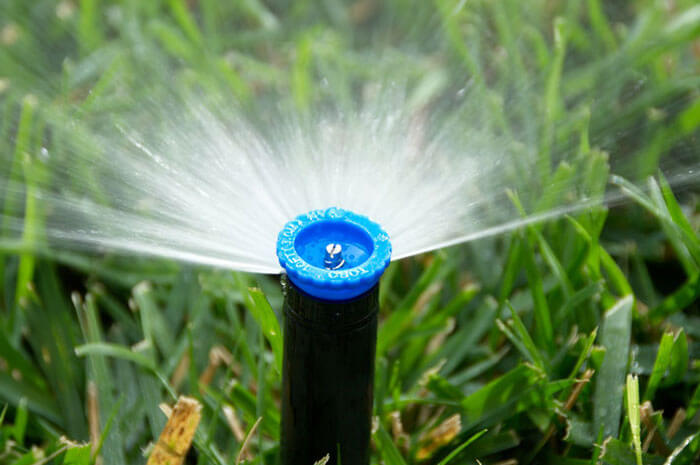
We all want the best for our yards. It’s where we play with family and friends during the warm months and the first thing we see as we walk up to or out of our homes. With a proper watering schedule, you’ll be well on your way to a lush, happy, and healthy lawn all season.
There are some catches with watering, and if done improperly, you could do more harm than good. Water at night, and you could give your grass a prime environment for harmful disease. Don’t water enough, and you’ll create a shallow root system.
Once you determine how often, how long, and the best time to water your lawn, you’ll be able to enjoy green grass all summer long.
Let’s learn the rules for proper watering.
Is Your Yard Even Thirsty?
Go out and take a walk on your lawn. If the grass has a bit of bounce and quickly pops back up, great! More than likely, it has adequate water and any extra watering could mean diseases and poor root systems. If your tracks stay pressed down, however, your yard probably needs to hydrate. For those who like firm numbers to measure against, your yard will need between 1” and 1.5” of water per week during peak growing season in spring and summer, depending on your location and climate. If rainfall isn’t cutting it, here are some tips on how to properly water to make sure your lawn is getting all the moisture it needs.
Make it Part of Your Morning Routine
The best time to water your lawn, especially in hot weather, is early in the morning when the air is cooler and the winds are low. This allows the water to penetrate deeply into the soil and grass root system with minimal evaporation. On the flip side, watering during the hottest parts of the day can lead to evaporation losses of up to 30%.
“I Thought it Was Best to Water in the Evening.”
Many people think that watering your yard in the evening means your yard can enjoy all that nice water without the hot sun cooking it off. This is true — sort of. For dry climates like those found in California, watering at night can be beneficial. However, if you live in a humid climate, watering at night makes your lawn susceptible to diseases and shouldn’t be done. You’re better off watering in the morning if you deal with humidity to avoid any problems.
Watch Where You Water
You don’t mow your sidewalk, driveway, or side of your house, so you don’t need to water it either. Also, shady areas don’t need as much water as their sun-drenched counterparts and will require less water to be happy. Adjusting your watering schedule accordingly will help eliminate water waste and keep your water bill in check.
Choose Your Sprinkler System
Unless you can control the rain, the most effective way to water your lawn is with a sprinkler system. Whether you choose a single above-ground sprinkler you move around the yard or an in-ground sprinkler system with sophisticated controls will influence how often and how long you will need to water your lawn.
- Above-ground sprinklers are generally the cheaper initial option, but they are less efficient and use more water, so you’ll need to be mindful of when and where you water your grass. Make sure you move your sprinkler for full yard coverage.
- In-ground irrigation systems with pop-up heads use controllers that can be set to go off at ideal times or day, and can be adjusted to only spray key areas. Make sure to monitor rainfall and moisture levels to avoid overwatering if your system does not take those into account.
- Sprinklers are generally categorized as either pulsating or oscillating. For new lawns, oscillating sprinklers are recommended because they are gentler and will not disrupt establishing root systems. Pulsating sprinklers are more forceful and can spray water over a larger area.
What is the Most Efficient Way to Water Your Lawn?
You don’t need to run your sprinklers long, just two or three times a week for short periods. This will help reduce excess runoff that comes from overwatered lawns and allow the water to penetrate deeper into the soil and allow the roots to flourish.
Get Down to the Roots
When the water does get deep into the soil, it promotes deep-root growth. Your lawn is getting the right amount of water when the soil is wet 6” down. To check, use a long screwdriver and drive it into the ground. If it easily reaches 6”, the soil is properly watered. If there is resistance, the soil is still too hard and dry and needs more water.
Change with the Seasons
Different seasons call for different approaches to watering your lawn. In the spring and summer, aim for an inch or inch-and-a-half. Begin to taper off the amount and frequency during the fall and stop watering entirely when the temperature begins to consistently drop below 40 degrees.
If you have a sprinkler irrigation system, adjust how often and how long you water your lawn based on seasonal weather conditions. Or, invest in a smart controller. It will adjust these settings automatically. We recommend Toro’s EVOLUTION series irrigation controller.
When paired with a Smart Connect® wireless weather sensor and the associated wireless accessories, the Toro EVOLUTION controller helps you better manage your water usage by using current temperature and solar measurements as well as historical weather data for a particular location to calculate the right amount of water needed from the irrigation system.
Listen to Your Yard
Following this guide is a great first step in the process of learning how to maintain a proper watering schedule for your lawn. And as you begin to recognize and respond to the needs of your yard, it will get even greener and healthier for you and your family to enjoy.



